The Allergy Tester Market is estimated to be valued at USD 33.2 billion in 2025 and is projected to reach USD 53.6 billion by 2035, registering a compound annual growth rate (CAGR) of 4.9% over the forecast period.
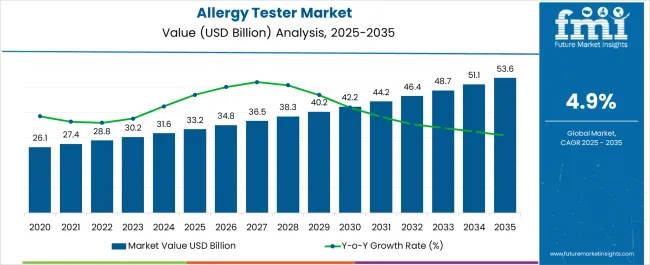
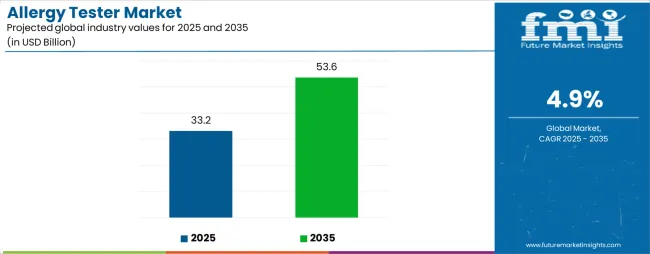
| Metric | Value |
|---|---|
| Allergy Tester Market Estimated Value in (2025 E) | USD 33.2 billion |
| Allergy Tester Market Forecast Value in (2035 F) | USD 53.6 billion |
| Forecast CAGR (2025 to 2035) | 4.9% |
The Allergy Tester Market is witnessing strong growth momentum, supported by the rising prevalence of allergic conditions worldwide and increasing awareness of early diagnosis. The current landscape reflects heightened demand from healthcare providers as patients seek reliable and minimally invasive testing options. Advancements in diagnostic technologies, coupled with the integration of digital data interpretation, are enabling more accurate detection of allergens.
The market is being further supported by expanding healthcare access in emerging regions, where awareness campaigns and improved insurance coverage are driving adoption. In developed economies, rising incidence of respiratory, skin, and food-related allergies has increased the uptake of advanced allergy testing devices.
The growing role of precision medicine and the trend toward personalized healthcare are also influencing the future outlook, as patients and providers shift toward targeted allergy management With healthcare infrastructure investments expanding and clinical practices emphasizing preventative diagnostics, the Allergy Tester Market is expected to maintain steady growth over the coming years, catering to diverse patient populations with evolving testing requirements.
The allergy tester market is segmented by test type, source of allergy, and geographic regions. By test type, allergy tester market is divided into Skin Prick Testing, Intradermal Testing, Patch Testing, Blood Testing, Provocation Testing, and Others. In terms of source of allergy, allergy tester market is classified into Food & Beverages, Pets, Environment, Soap & Shampoo, Jewelry, Drugs, and Others. Regionally, the allergy tester industry is classified into North America, Latin America, Western Europe, Eastern Europe, Balkan & Baltic Countries, Russia & Belarus, Central Asia, East Asia, South Asia & Pacific, and the Middle East & Africa.
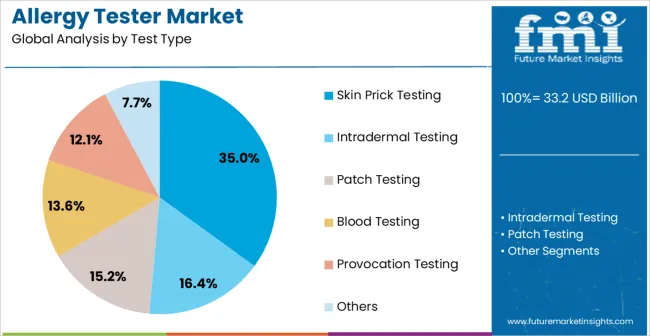
The Skin Prick Testing segment is projected to account for 35.00% of the Allergy Tester Market revenue share in 2025, making it the leading test type. This dominance is being attributed to the simplicity, cost-effectiveness, and high reliability of the skin prick method, which allows healthcare practitioners to identify allergic sensitivities with minimal patient discomfort.
The test’s ability to provide rapid and accurate results has increased its adoption across hospitals, diagnostic centers, and specialized clinics. The low invasiveness of this procedure, combined with its compatibility for both adult and pediatric patients, has expanded its use among diverse demographic groups.
In addition, the requirement of minimal equipment and resources has made it particularly suitable for widespread adoption in both developed and emerging healthcare systems The rising incidence of allergic conditions globally, combined with the demand for quick, safe, and affordable diagnostic procedures, has strengthened the position of skin prick testing as the most widely preferred method in allergy diagnostics, ensuring its continued dominance within the market.
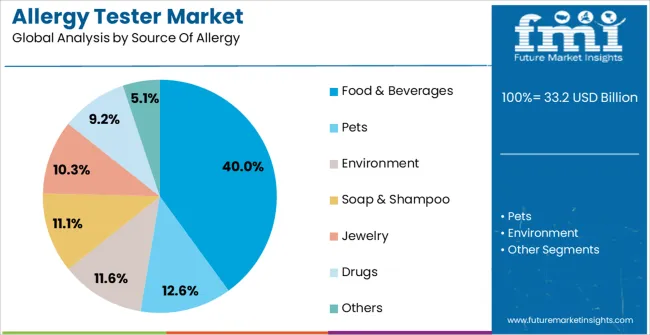
The Food and Beverages source of allergy segment is expected to capture 40.00% of the Allergy Tester Market revenue share in 2025, underscoring its leading role among allergy sources. This position has been reinforced by the rising global prevalence of food allergies, particularly to items such as nuts, dairy, seafood, and gluten-containing products, which have become increasingly recognized as major public health concerns.
The segment’s growth has been further supported by heightened consumer awareness, stricter food safety regulations, and the need for early and accurate detection of food sensitivities to prevent severe allergic reactions. The broad impact of food allergies on children and adults has intensified testing requirements, driving healthcare providers to expand diagnostic capabilities in this area.
Increasing research into food allergens and the development of specialized testing protocols have also improved detection accuracy, supporting widespread adoption As food allergies continue to affect a significant portion of the population globally, testing demand in this segment is expected to sustain growth, reinforcing its position as the largest revenue contributor in the Allergy Tester Market.
The growing trend of allergy home test kit is creating a huge demand for allergy tester and are significantly driving the global allergy tester market. Allergy tester is used to determine the substance causing an allergic reaction.
Allergy testers perform the test for allergies due to food, environment, insect, animal, skin, and other types of allergy. Skin allergy tester market is witnessing a huge demand due to the increasing skin issues. Vendors are offering skin allergy tester kit which are easy to use for customers to use in the home.
During the test, the skin is pricked with a small drop of allergen and exposed for about 20 minutes. The skin allergy tester monitors the skin for the sign of allergic reaction such as swelling or redness. This test is generally done for the cause of allergies such as mold, pollen, dust mites, pet dander, food, and others.
Skin allergy tester is considered safe for both adult and children. However, skin allergy tester is restricted for use to people with eczema or psoriasis.
Patch allergy testing is used to test the allergy because of soap, shampoo or jewelry. On patch allergy tester, the substance is placed between patch, and then is applied to the skin. It generally takes 2-3 days to give the result.
Blood allergy tester is used to determine the antibodies present in the blood. Some of the most used blood test method are E(IgE), radioallergosorbent testing (RAST), immunoassay capture test (ImmunoCAP), eosinophil counts, and others.
Blood allergy tester can test allergy occurring due to pet dander, dust, weeds, trees, grasses, molds, food, and others.
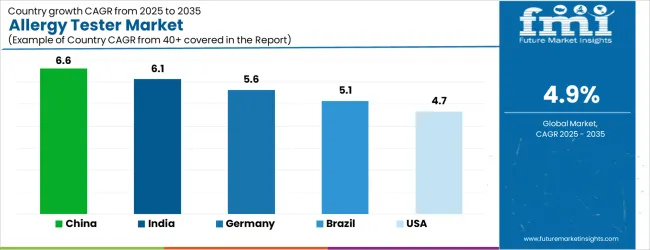
| Country | CAGR |
|---|---|
| China | 6.6% |
| India | 6.1% |
| Germany | 5.6% |
| Brazil | 5.1% |
| USA | 4.7% |
| UK | 4.2% |
| Japan | 3.7% |
The Allergy Tester Market is expected to register a CAGR of 4.9% during the forecast period, exhibiting varied country level momentum. China leads with the highest CAGR of 6.6%, followed by India at 6.1%. Developed markets such as Germany, France, and the UK continue to expand steadily, while the USA is likely to grow at consistent rates. Japan posts the lowest CAGR at 3.7%, yet still underscores a broadly positive trajectory for the global Allergy Tester Market.
In 2024, Germany held a dominant revenue in the Western Europe market and is expected to grow with a CAGR of 5.6%. The USA Allergy Tester Market is estimated to be valued at USD 12.2 billion in 2025 and is anticipated to reach a valuation of USD 12.2 billion by 2035. Sales are projected to rise at a CAGR of 0.0% over the forecast period between 2025 and 2035. While Japan and South Korea markets are estimated to be valued at USD 1.8 billion and USD 984.7 million respectively in 2025.
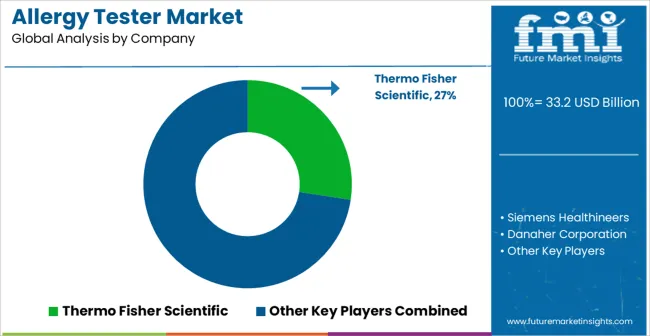
| Item | Value |
|---|---|
| Quantitative Units | USD 33.2 Billion |
| Test Type | Skin Prick Testing, Intradermal Testing, Patch Testing, Blood Testing, Provocation Testing, and Others |
| Source Of Allergy | Food & Beverages, Pets, Environment, Soap & Shampoo, Jewelry, Drugs, and Others |
| Regions Covered | North America, Europe, Asia-Pacific, Latin America, Middle East & Africa |
| Country Covered | United States, Canada, Germany, France, United Kingdom, China, Japan, India, Brazil, South Africa |
| Key Companies Profiled | Thermo Fisher Scientific, Siemens Healthineers, Danaher Corporation, Canon Inc., Abbott Laboratories, Beckman Coulter, bioMérieux, and ALK-Abelló |
The global allergy tester market is estimated to be valued at USD 33.2 billion in 2025.
The market size for the allergy tester market is projected to reach USD 53.6 billion by 2035.
The allergy tester market is expected to grow at a 4.9% CAGR between 2025 and 2035.
The key product types in allergy tester market are skin prick testing, intradermal testing, patch testing, blood testing, provocation testing and others.
In terms of source of allergy, food & beverages segment to command 40.0% share in the allergy tester market in 2025.






Our Research Products

The "Full Research Suite" delivers actionable market intel, deep dives on markets or technologies, so clients act faster, cut risk, and unlock growth.

The Leaderboard benchmarks and ranks top vendors, classifying them as Established Leaders, Leading Challengers, or Disruptors & Challengers.

Locates where complements amplify value and substitutes erode it, forecasting net impact by horizon

We deliver granular, decision-grade intel: market sizing, 5-year forecasts, pricing, adoption, usage, revenue, and operational KPIs—plus competitor tracking, regulation, and value chains—across 60 countries broadly.

Spot the shifts before they hit your P&L. We track inflection points, adoption curves, pricing moves, and ecosystem plays to show where demand is heading, why it is changing, and what to do next across high-growth markets and disruptive tech

Real-time reads of user behavior. We track shifting priorities, perceptions of today’s and next-gen services, and provider experience, then pace how fast tech moves from trial to adoption, blending buyer, consumer, and channel inputs with social signals (#WhySwitch, #UX).

Partner with our analyst team to build a custom report designed around your business priorities. From analysing market trends to assessing competitors or crafting bespoke datasets, we tailor insights to your needs.
Supplier Intelligence
Discovery & Profiling
Capacity & Footprint
Performance & Risk
Compliance & Governance
Commercial Readiness
Who Supplies Whom
Scorecards & Shortlists
Playbooks & Docs
Category Intelligence
Definition & Scope
Demand & Use Cases
Cost Drivers
Market Structure
Supply Chain Map
Trade & Policy
Operating Norms
Deliverables
Buyer Intelligence
Account Basics
Spend & Scope
Procurement Model
Vendor Requirements
Terms & Policies
Entry Strategy
Pain Points & Triggers
Outputs
Pricing Analysis
Benchmarks
Trends
Should-Cost
Indexation
Landed Cost
Commercial Terms
Deliverables
Brand Analysis
Positioning & Value Prop
Share & Presence
Customer Evidence
Go-to-Market
Digital & Reputation
Compliance & Trust
KPIs & Gaps
Outputs
Full Research Suite comprises of:
Market outlook & trends analysis
Interviews & case studies
Strategic recommendations
Vendor profiles & capabilities analysis
5-year forecasts
8 regions and 60+ country-level data splits
Market segment data splits
12 months of continuous data updates
DELIVERED AS:
PDF EXCEL ONLINE
Allergy Diagnostic Market Forecast and Outlook 2025 to 2035
Allergy Immunotherapy Market Analysis - Size, Share & Forecast 2025 to 2035
Market Share Breakdown of Allergy Immunotherapy Providers
Allergy Treatment Market Analysis - Demand & Forecast 2024 to 2034
5G Tester Market Growth – Trends & Forecast 2019-2027
RF Tester Market Growth – Trends & Forecast 2019-2027
LAN tester Market Size and Share Forecast Outlook 2025 to 2035
SCC Tester Market Size and Share Forecast Outlook 2025 to 2035
IgE Allergy Blood Tests Market Size, Growth, and Forecast 2025 to 2035
LED Tester Market
DSL Tester Market Growth – Trends & Forecast 2019-2027
Drug Tester Market Size and Share Forecast Outlook 2025 to 2035
Gold Tester Market Size and Share Forecast Outlook 2025 to 2035
Tube Tester Market Size and Share Forecast Outlook 2025 to 2035
CCTV Tester Market Size and Share Forecast Outlook 2025 to 2035
RFID Tester Market Size and Share Forecast Outlook 2025 to 2035
Pump Testers Market Size and Share Forecast Outlook 2025 to 2035
Food Allergy Market Size and Share Forecast Outlook 2025 to 2035
Food Allergy Immunotherapy Market Analysis Size and Share Forecast Outlook 2025 to 2035
Food Tester Market Size and Share Forecast Outlook 2025 to 2035

Thank you!
You will receive an email from our Business Development Manager. Please be sure to check your SPAM/JUNK folder too.
Chat With
MaRIA